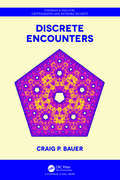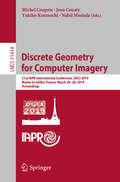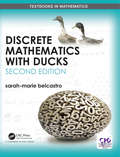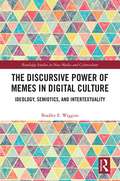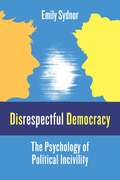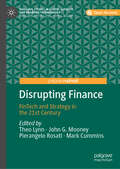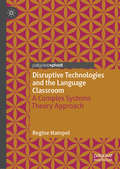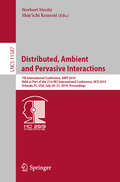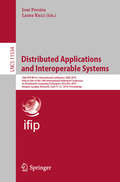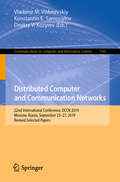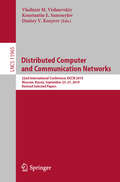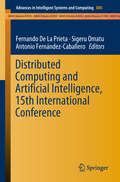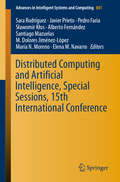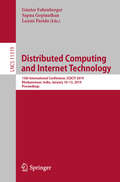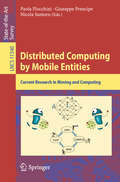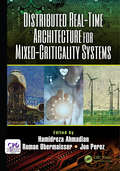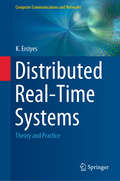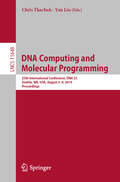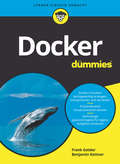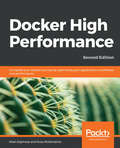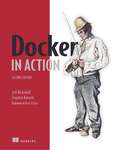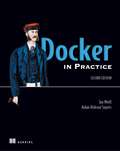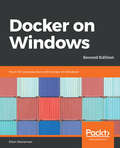- Table View
- List View
Discrete Encounters (Chapman & Hall/CRC Cryptography and Network Security Series)
by Craig BauerEschewing the standard dry and static writing style of traditional textbooks, Discrete Explorations provides a refreshing approach to discrete mathematics. The author combines traditional course topics with popular culture, applications, and various historical examples. This book focuses on the historical development of the subject and provides details on the people behind mathematics and their motivations, which will deepen readers’ appreciation of mathematics. With its unique style, the book covers many of the same topics found in other texts but done in an alternative, entertaining style that better captures readers’ attention. Defining discrete mathematics, the author also covers many different topics. These include combinatorics, fractals, permutations, difference equations, graph theory, trees and financial mathematics. Not only will readers gain a greater impression of mathematics, but they’ll be encouraged to further explore the subject. Highlights: Features fascinating historical references to motivate readers Text includes numerous pop culture references throughout to provide a more engaging reading experience Its unique topic structure presents a fresh approach The text’s narrative style reads more like a popular book instead of a dry textbook Covers many topics from combinatorics, as well as discrete mathematics
Discrete Geometry for Computer Imagery: 21st IAPR International Conference, DGCI 2019, Marne-la-Vallée, France, March 26–28, 2019, Proceedings (Lecture Notes in Computer Science #11414)
by Michel Couprie Jean Cousty Yukiko Kenmochi Nabil MustafaThis book constitutes the thoroughly refereed proceedings of the 21st IAPR International Conference on Discrete Geometry for Computer Imagery, DGCI 2019, held in Marne-la-Vallée, France, in March 2019. The 38 full papers were carefully selected from 50 submissions. The papers are organized in topical sections on discrete geometric models and transforms; discrete topology; graph-based models, analysis and segmentation; mathematical morphology; shape representation, recognition and analysis; and geometric computation.
Discrete Mathematics with Ducks (Textbooks in Mathematics)
by Sarah-Marie Belcastro<p>Discrete Mathematics with Ducks, Second Edition is a gentle introduction for students who find the proofs and abstractions of mathematics challenging. At the same time, it provides stimulating material that instructors can use for more advanced students. The first edition was widely well received, with its whimsical writing style and numerous exercises and materials that engaged students at all levels. <p>The new, expanded edition continues to facilitate effective and active learning. It is designed to help students learn about discrete mathematics through problem-based activities. These are created to inspire students to understand mathematics by actively practicing and doing, which helps students better retain what they’ve learned. As such, each chapter contains a mixture of discovery-based activities, projects, expository text, in-class exercises, and homework problems. The author’s lively and friendly writing style is appealing to both instructors and students alike and encourages readers to learn. The book’s light-hearted approach to the subject is a guiding principle and helps students learn mathematical abstraction.</p>
The Discursive Power of Memes in Digital Culture: Ideology, Semiotics, and Intertextuality (Routledge Studies in New Media and Cyberculture)
by Bradley E. WigginsShared, posted, tweeted, commented upon, and discussed online as well as off-line, internet memes represent a new genre of online communication, and an understanding of their production, dissemination, and implications in the real world enables an improved ability to navigate digital culture. This book explores cases of cultural, economic, and political critique levied by the purposeful production and consumption of internet memes. Often images, animated GIFs, or videos are remixed in such a way to incorporate intertextual references, quite frequently to popular culture, alongside a joke or critique of some aspect of the human experience. Ideology, semiotics, and intertextuality coalesce in the book’s argument that internet memes represent a new form of meaning-making, and the rapidity by which they are produced and spread underscores their importance.
Disrespectful Democracy: The Psychology of Political Incivility
by Professor Emily SydnorThe majority of Americans think that politics has an “incivility problem” and that this problem is only getting worse. Research demonstrates that negativity and rudeness in politics have been increasing for decades. But how does this tide of impolite-to-outrageous language affect our reactions to media coverage and our political behavior?Disrespectful Democracy offers a new account of the relationship between incivility and political behavior based on a key individual predisposition—conflict orientation. Individuals experience conflict in different ways; some enjoy arguments while others are uncomfortable and avoid confrontation. Drawing on a range of original surveys and experiments, Emily Sydnor contends that the rise of incivility in political media has transformed political involvement. Citizens now need to be able to tolerate or even welcome incivility in the public sphere in order to participate in the democratic process. Yet individuals who are turned off by incivility are not brought back in by civil presentation of issues. Sydnor considers the challenges in evaluating incivility’s normative benefits and harms to the political system: despite some detrimental aspects, certain levels of incivility in certain venues can promote political engagement, and confrontational behavior can be a vital tool in the citizen’s democratic arsenal. A rigorous and empirically informed analysis of political rhetoric and behavior, Disrespectful Democracy also proposes strategies to engage citizens across the range of conflict orientations.
Disrupting Finance: FinTech and Strategy in the 21st Century (Palgrave Studies in Digital Business & Enabling Technologies)
by Theo Lynn John G. Mooney Pierangelo Rosati Mark CumminsThis open access Pivot demonstrates how a variety of technologies act as innovation catalysts within the banking and financial services sector. Traditional banks and financial services are under increasing competition from global IT companies such as Google, Apple, Amazon and PayPal whilst facing pressure from investors to reduce costs, increase agility and improve customer retention. Technologies such as blockchain, cloud computing, mobile technologies, big data analytics and social media therefore have perhaps more potential in this industry and area of business than any other. This book defines a fintech ecosystem for the 21st century, providing a state-of-the art review of current literature, suggesting avenues for new research and offering perspectives from business, technology and industry.
Disruptive Technologies and the Language Classroom: A Complex Systems Theory Approach
by Regine HampelAlthough new technologies are embedded in students’ lives today, there is often an assumption that their use is transparent, inconsequential, or a distraction. This book combines complex systems theory with sociocultural theory and the multimodal theory of communication, providing an innovative theoretical framework to examine how communication and meaning-making in the language classroom have developed over time, how technology impacts on meaning-making, and what the implications are for learners, teachers, institutions and policy makers. Recent studies provide evidence for the disruptive effect of technology which has resulted in a phase shift that is reshaping language education by creating new interaction patterns, allowing for multimodal communication, and introducing real-world communication into the classroom. The book proposes ways of responding to this shift before concluding that the new technologies are radically transforming the way we learn. It is likely to appeal to a range of readers, including students, academics, teachers and policy-makers.
Distant Horizons: Digital Evidence and Literary Change
by Ted UnderwoodJust as a traveler crossing a continent won’t sense the curvature of the earth, one lifetime of reading can’t grasp the largest patterns organizing literary history. This is the guiding premise behind Distant Horizons, which uses the scope of data newly available to us through digital libraries to tackle previously elusive questions about literature. Ted Underwood shows how digital archives and statistical tools, rather than reducing words to numbers (as is often feared), can deepen our understanding of issues that have always been central to humanistic inquiry. Without denying the usefulness of time-honored approaches like close reading, narratology, or genre studies, Underwood argues that we also need to read the larger arcs of literary change that have remained hidden from us by their sheer scale. Using both close and distant reading to trace the differentiation of genres, transformation of gender roles, and surprising persistence of aesthetic judgment, Underwood shows how digital methods can bring into focus the larger landscape of literary history and add to the beauty and complexity we value in literature.
Distributed, Ambient and Pervasive Interactions: 7th International Conference, DAPI 2019, Held as Part of the 21st HCI International Conference, HCII 2019, Orlando, FL, USA, July 26–31, 2019, Proceedings (Lecture Notes in Computer Science #11587)
by Norbert Streitz Shin’ichi KonomiThis book constitutes the refereed proceedings of the 7th International Conference on Distributed, Ambient and Pervasive Interactions, DAPI 2019, held as part of the 21st International Conference on Human-Computer Interaction, HCII 2019, in Orlando, Florida, USA, in July 2019. A total of 1274 papers and 209 posters have been accepted for publication in the HCII 2019 proceedings from a total of 5029 submissions. The 36 papers included in this volume were organized in topical sections on IoT and big data; smart cities and built environments; perception and emotion in DAPI; and DAPI for health and learning.
Distributed Applications and Interoperable Systems: 19th IFIP WG 6.1 International Conference, DAIS 2019, Held as Part of the 14th International Federated Conference on Distributed Computing Techniques, DisCoTec 2019, Kongens Lyngby, Denmark, June 17–21, 2019, Proceedings (Lecture Notes in Computer Science #11534)
by José Pereira Laura RicciThis book constitutes the proceedings of the 19th IFIP International Conference on Distributed Applications and Interoperable Systems, DAIS 2019, held in Kongens Lyngby, Denmark, in June 2019, as part of the 14th International Federated Conference on Distributed Computing Techniques, DisCoTec 2019. The 9 full papers presented together with 2 short papers were carefully reviewed and selected from 28 submissions. The papers addressed challenges in multiple application areas, such as the Internet-of-Things, cloud and edge computing, and mobile systems. Some papers focused on middleware for managing concurrency and consistency in distributed systems, including data replication and transactions.
Distributed Computer and Communication Networks: 22nd International Conference, DCCN 2019, Moscow, Russia, September 23–27, 2019, Revised Selected Papers (Communications in Computer and Information Science #1141)
by Vladimir M. Vishnevskiy Konstantin E. Samouylov Dmitry V. KozyrevThis book constitutes the refereed proceedings of the 22nd International Conference on Distributed and Computer and Communication Networks, DCCN 2019, held in Moscow, Russia, in September 2019. The 50 full papers and 2 short papers were carefully reviewed and selected from 174 submissions. The papers cover the following topics: Computer and Communication Networks and Technologies, Analytical Modeling of Distributed Systems, and Distributed Systems Applications.
Distributed Computer and Communication Networks: 22nd International Conference, DCCN 2019, Moscow, Russia, September 23–27, 2019, Revised Selected Papers (Lecture Notes in Computer Science #11965)
by Vladimir M. Vishnevskiy Konstantin E. Samouylov Dmitry V. KozyrevThis book constitutes the refereed proceedings of the 22nd International Conference on Distributed and Computer and Communication Networks, DCCN 2019, held in Moscow, Russia, in September 2019. The 44 full papers and 2 short papers were carefully reviewed and selected from 174 submissions. The papers cover the following topics: Computer and Communication Networks, Analytical Modeling of Distributed Systems, and Distributed Systems Applications.
Distributed Computing and Artificial Intelligence, 15th International Conference (Advances In Intelligent Systems and Computing #800)
by Fernando De La Prieta Sigeru Omatu Antonio Fernández-CaballeroThe 15th International Symposium on Distributed Computing and Artificial Intelligence 2018 (DCAI 2018) is a forum to present applications of innovative techniques for studying and solving complex problems. The exchange of ideas between scientists and technicians from both the academic and industrial sector is essential to facilitate the development of systems that can meet the ever-increasing demands of today’s society. The present edition brings together past experience, current work and promising future trends associated with distributed computing, artificial intelligence and their application in order to provide efficient solutions to real problems.This symposium is organized by the University of Castilla-La Mancha, the Osaka Institute of Technology and the University of Salamanca. The present edition was held in Toledo, Spain, from 20th – 22nd June, 2018.
Distributed Computing and Artificial Intelligence, Special Sessions, 15th International Conference (Advances in Intelligent Systems and Computing #801)
by Sara Rodríguez Javier Prieto Pedro Faria Sławomir Kłos Alberto Fernández Santiago Mazuelas M. Dolores Jiménez-López María N. Moreno Elena M. NavarroThis book presents the outcomes of the 15th International Conference on Distributed Computing and Artificial Intelligence, held in Toledo (Spain) from 20th to 22nd June 2018 and hosted by the UCLM, and which brought together researchers and developers from industry, education and the academic world to report on the latest scientific research, technical advances and methodologies. Highlighting multi-disciplinary and transversal aspects, the book focuses on the conferences Special Sessions, including Advances in Demand Response and Renewable Energy Sources in Smart Grids (ADRESS); AI- Driven Methods for Multimodal Networks and Processes Modeling (AIMPM); Social Modelling of Ambient Intelligence in Large Facilities (SMAILF); Communications, Electronics and Signal Processing (CESP); Complexity in Natural and Formal Languages (CNFL); and Web and Social Media Mining (WASMM).
Distributed Computing and Internet Technology: 15th International Conference, ICDCIT 2019, Bhubaneswar, India, January 10–13, 2019, Proceedings (Lecture Notes in Computer Science #11319)
by Günter Fahrnberger Sapna Gopinathan Laxmi ParidaThis book constitutes the proceedings of the 15th International Conference on Distributed Computing and Internet Technology, ICDCIT 2019, held in Bhubaneswar, India, in January 2019.The 18 full papers and 14 short papers presented together with 5 invited papers were carefully reviewed and selected from 115 submissions. The papers present research in three areas: distributed computing, Internet technologies, and societal applications.
Distributed Computing by Mobile Entities: Current Research in Moving and Computing (Lecture Notes in Computer Science #11340)
by Paola Flocchini Giuseppe Prencipe Nicola SantoroDistributed Computing by Mobile Entities is concerned with the study of the computational and complexity issues arising in systems of decentralized computational entities operating in a spatial universe Encompassing and modeling a large variety of application environments and systems, from robotic swarms to networks of mobile sensors, from software mobile agents in communication networks to crawlers and viruses on the web, the theoretical research in this area intersects distributed computing with the fields of computational geometry (especially for continuous spaces), control theory, graph theory and combinatorics (especially for discrete spaces). The research focus is on determining what tasks can be performed by the entities, under what conditions, and at what cost. In particular, the central question is to determine what minimal hypotheses allow a given problem to be solved. This book is based on the lectures and tutorial presented at the research meeting on “Moving and Computing" (mac) held at La Maddalena Island in June 2017. Greatly expanded, revised and updated, each of the lectures forms an individual Chapter. Together, they provide a map of the current knowledge about the boundaries of distributed computing by mobile entities.
Distributed Real-Time Architecture for Mixed-Criticality Systems
by Hamidreza Ahmadian Roman Obermaisser Jon PerezThis book describes a cross-domain architecture and design tools for networked complex systems where application subsystems of different criticality coexist and interact on networked multi-core chips. The architecture leverages multi-core platforms for a hierarchical system perspective of mixed-criticality applications. This system perspective is realized by virtualization to establish security, safety and real-time performance. The impact further includes a reduction of time-to-market, decreased development, deployment and maintenance cost, and the exploitation of the economies of scale through cross-domain components and tools. Describes an end-to-end architecture for hypervisor-level, chip-level, and cluster level. Offers a solution for different types of resources including processors, on-chip communication, off-chip communication, and I/O. Provides a cross-domain approach with examples for wind-power, health-care, and avionics. Introduces hierarchical adaptation strategies for mixed-criticality systems Provides modular verification and certification methods for the seamless integration of mixed-criticality systems. Covers platform technologies, along with a methodology for the development process. Presents an experimental evaluation of technological results in cooperation with industrial partners. The information in this book will be extremely useful to industry leaders who design and manufacture products with distributed embedded systems in mixed-criticality use-cases. It will also benefit suppliers of embedded components or development tools used in this area. As an educational tool, this material can be used to teach students and working professionals in areas including embedded systems, computer networks, system architecture, dependability, real-time systems, and avionics, wind-power and health-care systems.
Distributed Real-Time Systems: Theory and Practice (Computer Communications and Networks)
by K. ErciyesThis classroom-tested textbook describes the design and implementation of software for distributed real-time systems, using a bottom-up approach. The text addresses common challenges faced in software projects involving real-time systems, and presents a novel method for simply and effectively performing all of the software engineering steps. Each chapter opens with a discussion of the core concepts, together with a review of the relevant methods and available software. This is then followed with a description of the implementation of the concepts in a sample kernel, complete with executable code.Topics and features: introduces the fundamentals of real-time systems, including real-time architecture and distributed real-time systems; presents a focus on the real-time operating system, covering the concepts of task, memory, and input/output management; provides a detailed step-by-step construction of a real-time operating system kernel, which is then used to test various higher level implementations; describes periodic and aperiodic scheduling, resource management, and distributed scheduling; reviews the process of application design from high-level design methods to low-level details of design and implementation; surveys real-time programming languages and fault tolerance techniques; includes end-of-chapter review questions, extensive C code, numerous examples, and a case study implementing the methods in real-world applications; supplies additional material at an associated website.Requiring only a basic background in computer architecture and operating systems, this practically-oriented work is an invaluable study aid for senior undergraduate and graduate-level students of electrical and computer engineering, and computer science. The text will also serve as a useful general reference for researchers interested in real-time systems.
Diventa Un Esperto di Apple HomePod: La Guida Ufficiale HomePod IOS 12
by Adidas WilsonIl nuovo dispositivo HomePod offre un servizio semplice e sorprendente per gli utenti Apple di godersi AirPlay, Apple Music e controllare i dispositivi HomeKit da qualsiasi luogo. HomePod non è stato creato per essere un concorrente di Google Home o Amazon Echo, così come il MacBook Air non era progettato per competere con il netbook. Certo, entrambi condividono un certo numero di caratteristiche . Ad esempio, l'altoparlante HomePod può essere controllato vocalmente e il MacBook Air è compatto e leggero. Tuttavia, HomePod è un assistente domestico da 350 dollari ; molto simile al MacBook, un computer portatile da 200 dollari. Il Fire Phone di Amazon non è stato un successo. Alexa, quindi, ha dovuto vendere molto in modo che Prime potesse restare nella vita di molti utenti. Questo risultò un successo grazie ai prezzi contenuti di Echo. Quando si tratta di HomePod, però, la questione cambia. AirPod è stato progettato per aiutarti a godere la tua musica preferita mentre sei in viaggio, mentre HomePod è stato progettato per ascoltare la tua musica preferita comodamente a casa tua.
DNA Computing and Molecular Programming: 25th International Conference, DNA 25, Seattle, WA, USA, August 5–9, 2019, Proceedings (Lecture Notes in Computer Science #11648)
by Chris Thachuk Yan LiuThis book constitutes the refereed proceedings of the 25th International Conference on DNA Computing and Molecular Programming, DNA 25, held in Seattle, WA, USA, in August 2019.The 12 full papers presented were carefully selected from 19 submissions. The papers cover a wide range of topics relating to biomolecular computing such as algorithms and models for computation on biomolecular systems; computational processes in vitro and in vivo; molecular switches, gates, devices, and circuits; molecular folding and self-assembly of nanostructures; analysis and theoretical models of laboratory techniques; molecular motors and molecular robotics; information storage; studies of fault-tolerance and error correction; software tools for analysis, simulation, anddesign; synthetic biology and in vitro evolution; and applications in engineering, physics, chemistry, biology, and medicine.
Docker für Dummies (Für Dummies)
by Frank Geisler Benjamin KettnerHaben Sie Ihre Software schon »containerisiert«? Wissen Sie, wie Sie die Container-Technologie am besten in Ihrem Unternehmen einsetzen können? Wenn nicht, dann sollten Sie jetzt damit beginnen, sich mit dieser Technologie auseinanderzusetzen, da es im Schnitt alle zehn Jahre eine Revolution in der IT gibt. Und nun ist es wieder so weit: Docker erobert die Welt. Dieses Buch stellt die Docker-Technologie vor und präsentiert viele praxisrelevante Beispiele, wie diese Technologie gewinnbringend eingesetzt werden kann. Anschließend wissen Sie, wie Sie Docker für Ihre eigenen Zwecke nutzen können.
Docker High Performance: Complete your Docker journey by optimizing your application's workflows and performance, 2nd Edition
by Allan Espinosa Russ McKendrickLeverage Docker to unlock efficient and rapid container deployments to improve your development workflowKey FeaturesReconfigure Docker hosts to create a logging system with the ElasticSearch-Logstash-Kibana (ELK) stackTackle the challenges of large-scale container deployment with this fast-paced guideBenchmark the performance of your Docker containers using Apache JMeterBook DescriptionDocker is an enterprise-grade container platform that allows you to build and deploy your apps. Its portable format lets you run your code right from your desktop workstations to popular cloud computing providers. This comprehensive guide will improve your Docker workflows and ensure your application's production environment runs smoothly.This book starts with a refresher on setting up and running Docker and details the basic setup for creating a Docker Swarm cluster. You will then learn how to automate this cluster by using Chef Server and Cookbook. After that, you will run the Docker monitoring system with Prometheus and Grafana, and deploy the ELK stack. You will also learn some tips for optimizing Docker images.After deploying containers with the help of Jenkins, you will then move on to a tutorial on using Apache JMeter to analyze your application's performance. You will learn how to use Docker Swarm and NGINX to load-balance your application and how common debugging tools in Linux can be used to troubleshoot Docker containers.By the end of this book, you will be able to integrate all the optimizations that you have learned and put everything into practice in your applications.What you will learnAutomate provisioning and setting up nodes in a Docker Swarm clusterConfigure a monitoring system with Prometheus and GrafanaUse Apache JMeter to create workloads for benchmarking the performance of Docker containersUnderstand how to load-balance an application with Docker Swarm and NginxDeploy strace, tcdump, blktrace, and other Linux debugging tools to troubleshoot containersIntegrate Docker optimizations for DevOps, Site Reliability Engineering, CI, and CDWho this book is forIf you are a software developer with a good understanding of managing Docker services and the Linux file system and are looking for ways to optimize working with Docker containers, then this is the book for you. Developers fascinated with containers and workflow automation with benefit from this book.
Docker in Action
by Jeffrey Nickoloff Stephen KuenzliEven small applications have dozens of components. Large applications may have thousands, which makes them challenging to install, maintain, and remove. Docker bundles all application components into a package called a container that keeps things tidy and helps manage any dependencies on other applications or infrastructure. Docker in Action, Second Edition teaches you the skills and knowledge you need to create, deploy, and manage applications hosted in Docker containers. This bestseller has been fully updated with new examples, best practices, and entirely new chapters. You'll start with a clear explanation of the Docker model and learn how to package applications in containers, including techniques for testing and distributing applications.Purchase of the print book includes a free eBook in PDF, Kindle, and ePub formats from Manning Publications.
Docker in Practice
by Ian Miell Aidan SayersSummaryDocker in Practice, Second Edition presents over 100 practical techniques, hand-picked to help you get the most out of Docker. Following a Problem/Solution/Discussion format, you'll walk through specific examples that you can use immediately, and you'll get expert guidance on techniques that you can apply to a whole range of scenarios.Purchase of the print book includes a free eBook in PDF, Kindle, and ePub formats from Manning Publications.About the TechnologyDocker's simple idea-wrapping an application and its dependencies into a single deployable container-created a buzz in the software industry. Now, containers are essential to enterprise infrastructure, and Docker is the undisputed industry standard. So what do you do after you've mastered the basics? To really streamline your applications and transform your dev process, you need relevant examples and experts who can walk you through them. You need this book. About the BookDocker in Practice, Second Edition teaches you rock-solid, tested Docker techniques, such as replacing VMs, enabling microservices architecture, efficient network modeling, offline productivity, and establishing a container-driven continuous delivery process. Following a cookbook-style problem/solution format, you'll explore real-world use cases and learn how to apply the lessons to your own dev projects.What's insideContinuous integration and deliveryThe Kubernetes orchestration toolStreamlining your cloud workflowDocker in swarm modeEmerging best practices and techniquesAbout the ReaderWritten for developers and engineers using Docker in production.About the AuthorIan Miell and Aidan Hobson Sayers are seasoned infrastructure architects working in the UK. Together, they used Docker to transform DevOps at one of the UK's largest gaming companies.Table of ContentsPART 1 - DOCKER FUNDAMENTALSDiscovering DockerUnderstanding Docker: Inside the engine roomPART 2 - DOCKER AND DEVELOPMENTUsing Docker as a lightweight virtual machineBuilding imagesRunning containersDay-to-day DockerConfiguration management: Getting your house in orderPART 3 - DOCKER AND DEVOPSContinuous integration: Speeding up your development pipeline Continuous delivery: A perfect fit for Docker principlesNetwork simulation: Realistic environment testing without the painPART 4 - ORCHESTRATION FROM A SINGLE MACHINE TO THE CLOUDA primer on container orchestrationThe data center as an OS with DockerDocker platformsPART 5 - DOCKER IN PRODUCTIONDocker and securityPlain sailing: Running Docker in productionDocker in production: Dealing with challenges
Docker on Windows - Second Edition: From 101 to production with Docker on Windows, 2nd Edition
by Elton StonemanIf you want to modernize an old monolithic application without rewriting it, smooth the deployment to production, or move to DevOps or the cloud, then Docker is the enabler for you. This book gives you a solid grounding in Docker so you can confidently approach all of these scenarios.
